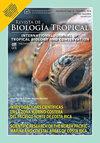Ontogeny of digestive enzymes in clown anemonefish larvae, Amphiprion ocellaris (Perciformes: Pomacentridae)
IF 0.6
4区 生物学
Q4 BIOLOGY
引用次数: 0
Abstract
Introduction: Clown anemonefish (Amphiprion ocellaris) is the most popular fish species in the marine aquarium trade, however, there is a lack of information on their digestive physiology during larvae ontogeny, valuable information that helps in the design of specific diets, as well as management protocols for the species. Objective: Characterize the early development of digestive enzymes of A. ocellaris during larvae ontogeny. Methods: From hatching until the 38th day after hatching (DAH), the specific activity of acid and alkaline proteases, trypsin, chymotrypsin, leucine aminopeptidase and lipase were analyzed, while acid and alkaline proteases zymograms were performed. Results: At hatching, all measured enzymes activities were detected. Acid proteases increased in activity from hatching until the 38th DAH. Alkaline proteases, trypsin, chymotrypsin, and leucine aminopeptidase showed the same pattern and maximum activity on the 8th DAH, decreasing at the 38th DAH. Lipase activity showed peaks on the 8th and 30th DAH. Acid zymogram showed a single band, appearing on the 8th DAH. A total of eight alkaline proteases were revealed (154.2, 128.1, 104.0, 59.8, 53.5, 41.9, 36.5 and 25.1 KDa), showing seven bands on the 1st DAH and all bands from the 3rd to 8th DAH, decreasing at two bands (41.9 and 25.1 KDa) in the 38th DAH. Conclusion: A. ocellaris shows a functional stomach on the 8th DAH, where the species on the 38th DAH shows digestive enzymatic pattern to omnivore with a tendency to carnivory. Objective: Characterize the early development of digesive enzymes of A. ocellaris during larval ontogeny. Methods: From hatching until the 38th days after hatching (DAH), the specific activity of acid and alkaline proteases, trypsin, chymotrypsin, leucine aminopeptidase and lipase were analysed, while acid and alkaline proteases zymograms were perfomed. Results: At hatching, all measured enzymes activities were detected. Acid proteases increased in activity from hatching until the 38th DAH. Alkaline proteases, trypsin, chymotrypsin and leucine aminopeptidase showed same pattern and maximum activity on the 8th DAH, decreasing at the 38th DAH. Lipase showed activity peaks on the 8th and 30th DAH. Acid zymogram showed a single band, appearing on the 8th DAH. Total of eight alkaline proteases were reveled (154.2, 128.1, 104.0, 59.8, 53.5, 41.9, 36.5 and 25.1 KDa), showing seven bands on the 1st DAH and all band from the 3rd to 8th DAH, decreasing at two bands (41.9 and 25.1 KDa) in the 38th DAH. Conclusion: Therefore, A. ocellaris shows functional stomach on the 8th DAH, where the species on the 38th DAH shows digestive enzymatic pattern to omnivore with a tendency to carnivory.小丑海葵幼虫消化酶的个体发生,角头两栖纲(鲈形目:珍珠科)
简介:小丑海葵鱼(Amphitrion ocellaris)是海洋水族馆贸易中最受欢迎的鱼类,然而,缺乏关于其幼虫个体发育过程中消化生理的信息,也缺乏有助于设计特定饮食的宝贵信息,以及该物种的管理协议。目的:研究毛毛虫幼虫个体发育过程中消化酶的早期发育特点。方法:从孵化到孵化后第38天(DAH),分析酸性和碱性蛋白酶、胰蛋白酶、糜蛋白酶、亮氨酸氨基肽酶和脂肪酶的比活性,并进行酸性和碱性酶的酶谱分析。结果:在孵化时,所有测得的酶活性均得到检测。酸性蛋白酶从孵化到第38个DAH活性增加。碱性蛋白酶、胰蛋白酶、糜蛋白酶和亮氨酸氨肽酶在第8天表现出相同的模式和最大活性,在第38天下降。脂肪酶活性在第8天和第30天达到峰值。酸性酶谱显示单一条带,出现在第8个DAH。共发现8种碱性蛋白酶(154.2128.1104.0,59.8,53.5,41.9,36.5和25.1KDa),在第1个DAH显示7条带,在第3个至第8个DAH所有带,第38个DAH减少两条带(41.9和25.1KDa.)。结论:A.ocellaris在第8个DAH表现出功能性胃,而在第38个DAH的物种表现出杂食性的消化酶模式,并有肉食性的倾向。目的:研究毛毛虫幼虫个体发育过程中消化酶的早期发育特点。方法:从孵化到孵化后38d(DAH),分析酸性和碱性蛋白酶、胰蛋白酶、糜蛋白酶、亮氨酸氨基肽酶和脂肪酶的比活性,并对酸性和碱性酶进行酶谱分析。结果:在孵化时,所有测得的酶活性均得到检测。酸性蛋白酶从孵化到第38个DAH活性增加。碱性蛋白酶、胰蛋白酶、糜蛋白酶和亮氨酸氨肽酶在第8天表现出相同的模式和最高活性,在第38天下降。脂肪酶在第8天和第30天出现活性高峰。酸性酶谱显示单一条带,出现在第8个DAH。共检测到8种碱性蛋白酶(154.2128.1104.0,59.8,53.5,41.9,36.5和25.1KDa),在第1个DAH显示7条带,在第3到第8个DAH出现全部带,第38个DAH减少两条带(41.9和25.1KDa.)。结论:毛毛虫在第8天表现为功能性胃,第38天表现为杂食性消化酶型,有肉食性倾向。
本文章由计算机程序翻译,如有差异,请以英文原文为准。
求助全文
约1分钟内获得全文
求助全文
来源期刊

Revista De Biologia Tropical
生物-生物学
CiteScore
1.80
自引率
0.00%
发文量
23
审稿时长
4-8 weeks
期刊介绍:
The Revista de Biología Tropical / International Journal of Tropical Biology and Conservation is a mainstream scientific journal published since 1953 and covered by Web of Science; Science Citation Index; Current Contents; Google Scholar; Scopus, SciELO and nearly 50 additional indices.
A double blind system guarantees you a fair evaluation, and our world class editorial and scientific boards provides a first decision in three working days. The journal is Full Open Access and is widely read where your article can have the highest real impact.
Since its beginning in 1953, the Revista follows these principles: objective and independent evaluation of all manuscripts; transparency in all processes; ethical use of procedures, data, specimens and subjects; fair treatment of all parties; and absolute predominance of scientific rigor over any other aspect.
 求助内容:
求助内容: 应助结果提醒方式:
应助结果提醒方式:


